Those who make art often use their creativity to respond to, reflect on, and contemplate the world around them. Art-making is a framework for considering, questioning, and representing the human condition in abstract and material ways–artists are continuously referencing physical, social, and perceptual elements of humanity in their practices. Food has been a prominent theme in artistic creations for centuries, as nourishment is an essential human existence component. As a metaphorical subject, food regularly connects to existential concepts. For instance, the pictorial representation of food often elicits themes related to concepts of spirituality, transformation, consumption, indulgence, and sexuality. Throughout history, the symbolic nature of foodstuffs and imagery of food in art has also initiated conversations about the changing economic and social positions of the world, including conditions of capitalism and cultural disparity.
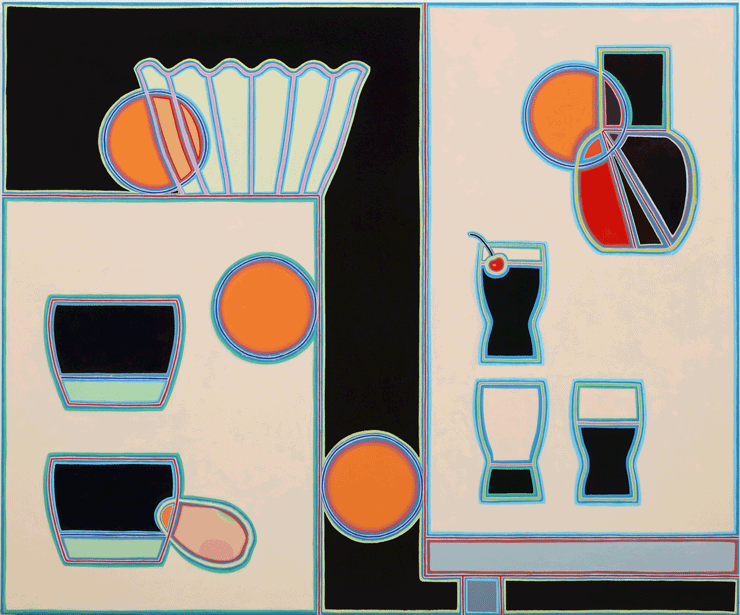
Food Still Lifes as Classic Explorations of Everyday Commodities, Consumption, and Colour
The genre of still life is one of the principal subject types seen throughout Western art history. According to the Tate, “Still life can be a celebration of material pleasures such as food and wine, or often a warning of the ephemerality of these pleasures and the brevity of human life.” With symbolic importance and distinct aesthetic detail, seventeenth-century Dutch still life paintings depicted everyday foods such as bread, fruit, cheese, and milk. “More than being a matter of pleasurable contemplation, food still lifes were also clearly mirrors of the prevalent social and cultural circumstances” (Forschner, 93). In later centuries, colonial and economic prosperity brought wealth and new agriculture to European nations. European societies, and in return, artists, became interested in the new benefits of everyday life such as education, commerce, and material goods. For seventeenth-century viewers, images of fruit, vegetables, and other natural foods seen in paintings were known as divine and sometimes sexual cues that added symbolic and perceptual depth to classic compositions.
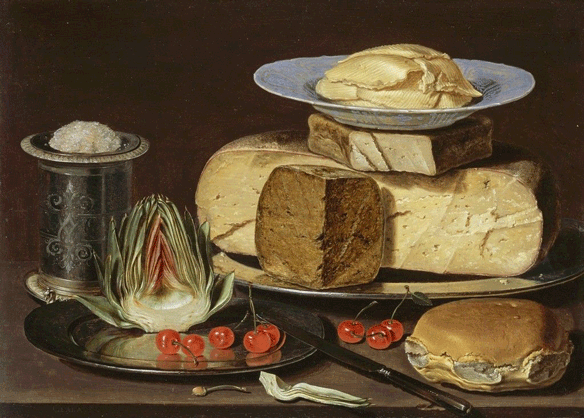
After the Dutch Golden Age, the genre of still life painting lost its once impressive credence. By the last quarter of the nineteenth century, the practice of Impressionism characterized a significant portion of European painting. Artists sought to paint images of life and society in a way that would “accurately and objectively record visual reality in terms of transient effects of light and colour.” Still, life images were seen as purely decorative and devoid of symbolic or impactful meaning. However, in the late 1800s, the artist Paul Cézanne reinvented the genre when he revisited still life images under a post-Impressionist lens. Deriving various compositions filled with apples, pears, peaches, and cherries, Cézanne used fruit to explore connections between objects, distort visual perspective, and create compositions that realized a harmony of light, shadow, and colour. For many historians and artists, Cézanne’s practice elevated him to one of the leaders of modernism because his approach to the subject matter, colouration, and technique are believed to have influenced later movements of fauvism and cubism.
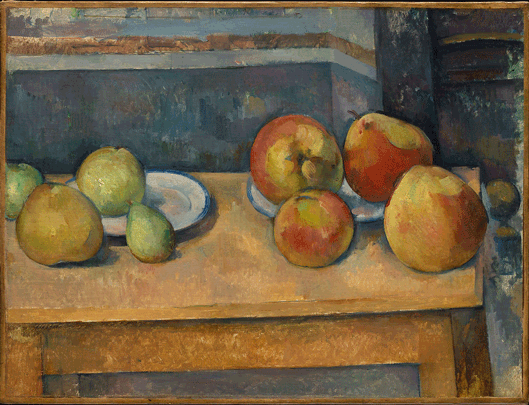
In the mid-1950s, California artist Wayne Thiebaud began painting still life images of diner-style food items, including confections such as tiered cakes, sundaes, donuts, and savoury dishes like turkey dinner and egg salad. His work “combined a number of interests then current in American art: thick, gestural brushwork, everyday subject matter, and commercial imagery.” While various graphic artists are working at this time referenced the commodification and consumerism of everyday objects (including food) in their work as observation or critique of societal products, Thiebaud generated paintings that adoringly emphasized a nostalgia “for the rituals and traditions of American life.” Although these bright and methodical paintings appear simplistic and jovial, Thiebaud meticulously crafted his images in an attempt to give seriousness to a uniquely American memory of food in post-war and post-depression culture.
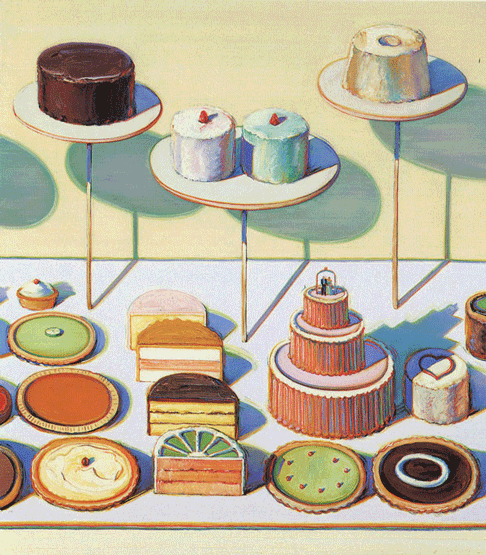
Canadian-born contemporary artist Sara Cwynar “investigates themes that lay the groundwork for capitalist societies—obsolescence, consumption, technology and labour—interrogating them all ‘through the lens of colour.’” By combining and categorizing everyday objects into staged still lifes and studies of colour, Cwynar delves into the relationship between objects, images of said objects, and their value. Her work is influenced by familiar tropes seen in food photography, discarded commercial still lifes, and stock images. For Cwynar, vernacular images, such as still lifes, “help shape our view of the world and how this changes over time.” In her images, ephemeral foodstuffs’ appearance alongside valuable artifacts create a conversation surrounding cultural perceptions of what is considered valuable, perishable, and everlasting.
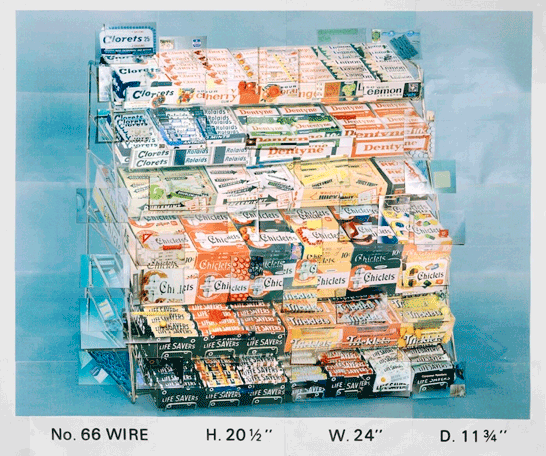
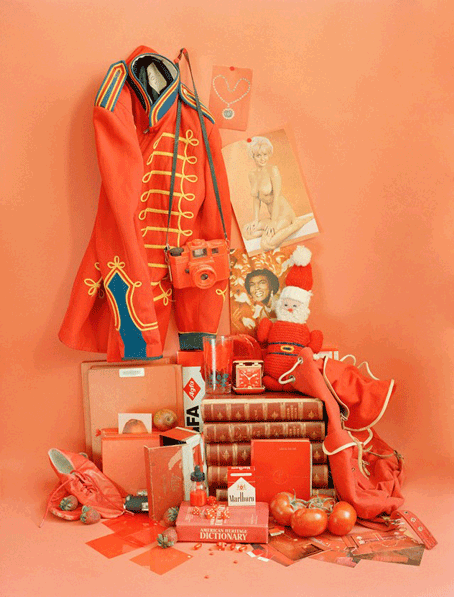
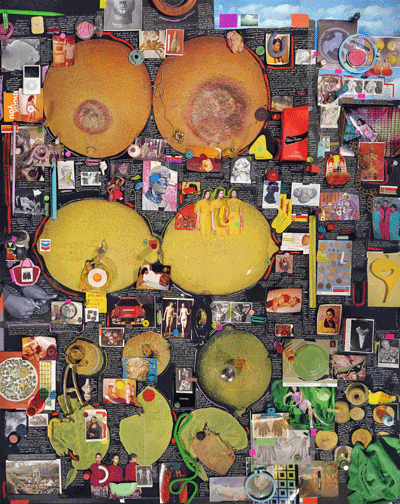
Artist’s Subject: Food Celebrations are Symbolic of More than Physical Nourishment
Christian L. Rock contends that “Even in its most unassuming forms, sustenance is densely layered with significance relative to personal and broader cultural memory, larger politics, and, of course, sensory response.” On a global stage, artists also use food in their work to contextualize the complicated political and historical underpinnings of human consumption. In his work, Mexican born artist Raúl Ortega Ayala explores humans’ ethnographic relationship to food beyond bodily sustenance to investigate “its intrinsic significance in life's rituals and cycles, its role in religion and culture, as well as its interconnections with our emotions and psychologies.”
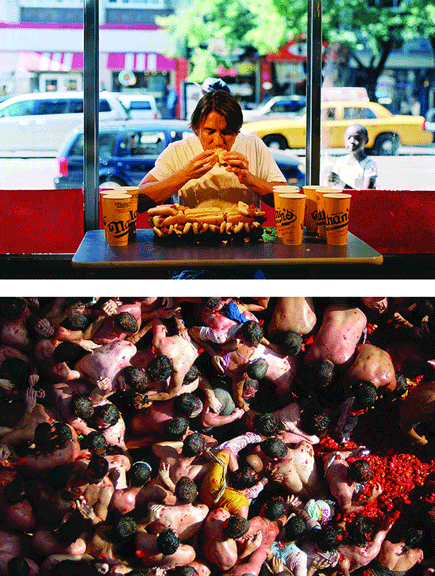
His two-channel film, Tomatina-Tim, once presented at the exhibition Food for Thought in Mexico City in 2016, frames side-by-side depictions of two cultural celebrations that involve food. In one panel, a male figure is seen sitting at a table participating in the famous American hot dog eating contest at Nathan’s restaurant in Coney Island, New York. The second panel shows clips from the annual La Tomatina tomato-throwing Festival in Buñol, Spain, where every year over 45,000 civilian participants are “run red with over 120 tons of vegetable juice.” Ortega Ayala’s work creates a conversation about the sanctity and morality of celebratory traditions that promote an exorbitant consumption and food waste. He questions the sacred significance of these events as they seemingly exist to promote indulgence, gluttony, and a celebration of excess.
Wendy Red Star is a contemporary mixed-media artist of Apsáalooke (Crow) descent who uses her practice to critique and reclaim colonized perceptions of her ancestry. As “an avid researcher of archives and historical narratives, Red Star seeks to incorporate and recast her research, offering new and unexpected perspectives in work that is at once inquisitive, witty and unsettling.” Recently re-released by Haw Contemporary, Red Star’s 2006 photograph The Last Thanks positions the artist as a subject of a quaint American Thanksgiving dinner –– a feast with oatmeal crème pies and wonder bread bologna sandwiches attended by guest skeletons attiring crafty headdresses. Haw Contemporary expresses that in the image, “Red Star forces her viewer to grapple with difficult knowledge, challenging conventional stereotypes of native people that mainstream settler culture upholds and promotes.” The skeletons in the image reference both the genocide of Indigenous peoples and also acknowledges the stereotype that Indigenous cultures, as well as practices, are no longer alive. The Last Thanks creates a layered satirical critique of mass celebrations while again using food to symbolically represent ideas of class, cultural difference, and colonial histories. Red Star’s imagery reminds viewers that the celebratory day of thanks, blessings, and food enjoyment for some can simultaneously represent a day of remembrance for the lost lives of fellow peoples –– a signal of an oppressive history.
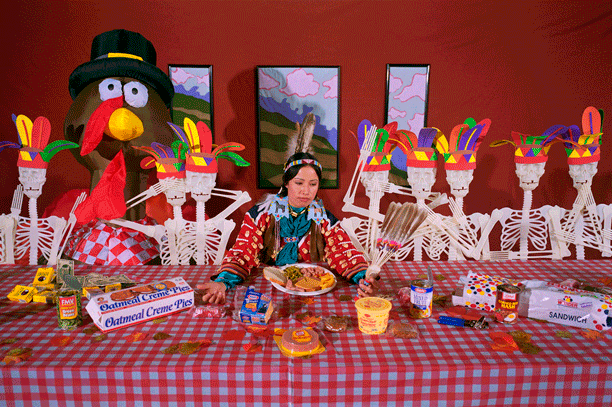
As stated by Anja Foerschner, “Food is a vital aspect of personal and cultural identity and often carries numerous associations” (97). For centuries, artists have reimagined images and representations of foodstuffs in their work to document time, cross-examine societal perceptions and practices involving food, and to critique humanity’s habitual relationship with consumption, excess, and celebration.
